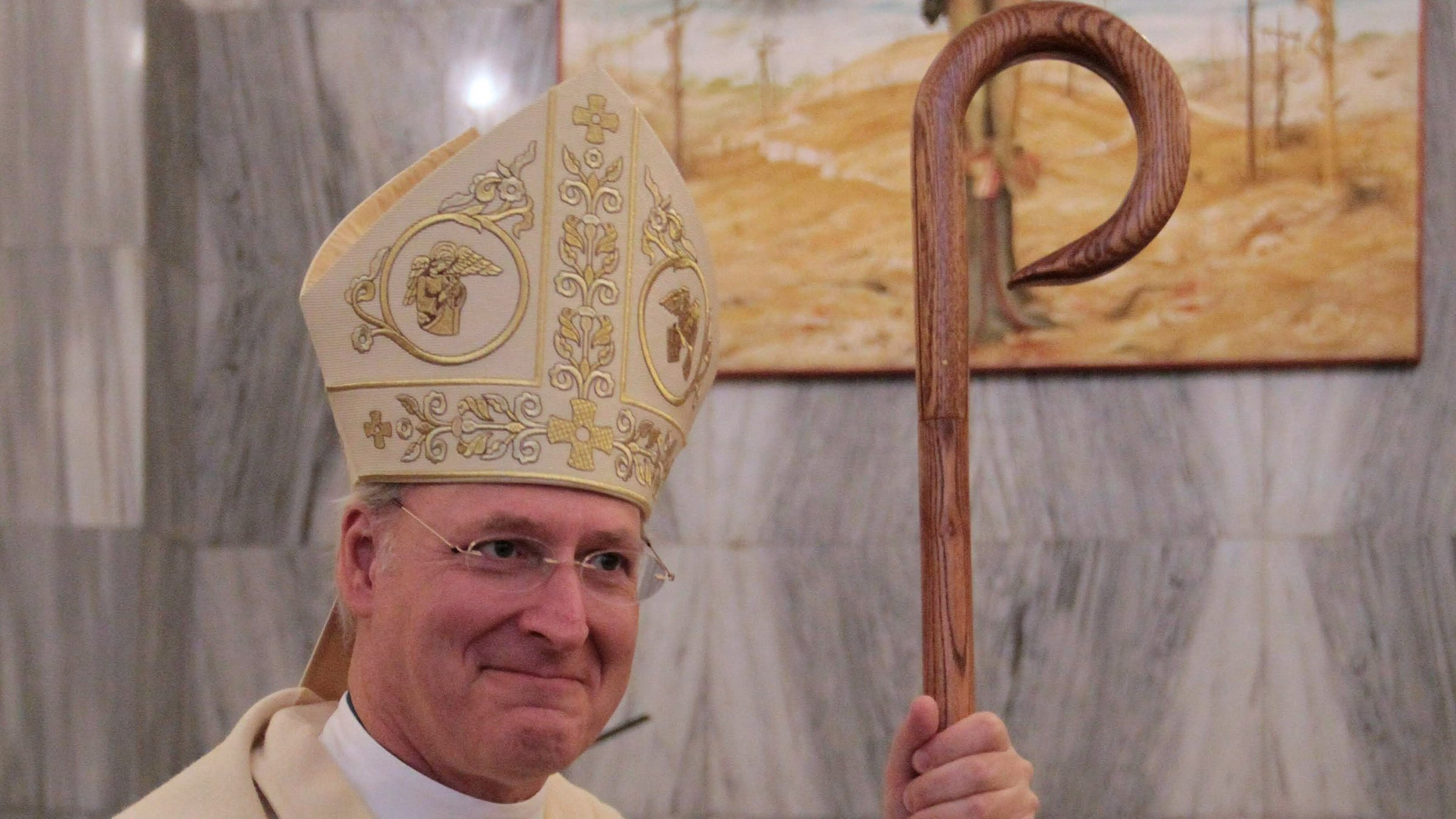Pectoral cross, episcopal ring and crosier carry personal history, including ties to his hometown and a 19th century Detroit priest
DETROIT — When a priest of the Roman Catholic Church becomes a bishop, he is entitled to wear certain vestments and utilize specific liturgical adornments. In addition to the colorful cassock and sash, bishops are identified by the following articles:
Miter
Pointed headwear worn only by the pope, cardinals, bishops and occasionally abbots and monsignors, the miter is of Roman origin. It derived from a non-liturgical papal head covering called the “camelaucum,” a helmet-shaped cap. Use of the miter began as early as the eighth century and has evolved through many shapes and designs. By about 1100 to 1150 A.D., the custom of wearing the miter was common among bishops.
Crosier
A symbol of episcopal office since the early days of the Church, the crosier is given to bishops during the consecration liturgy. Durandus, an early Church writer, explained the significance of the croser: “The end is sharp to goad the slothful, the middle is straight to signify righteous rule, while the head is bent to draw in and attract souls to the way of God.” In the past, bishops and archbishops carried their crosiers with the crook turned outward, while auxiliaries carried them with the crook facing inward.
Archbishop Russell’s crosier was designed by a friend in Alpena, and is made from Michigan ash. The crosier also contains pieces of wood from the steeple of his home parish, St. Bernard of Clairvaux in Alpena.
Ring
Worn on the fourth finger of the right hand, the ring is a sign of a bishop’s betrothal to his Church. A decree from Pope Boniface IV in 610 A.D. and documents from the Fourth Council of Toledo in 633 A.D. are the first recorded mentions of a ring as an ornament of the office of bishop. Also in the 600s, St. Isidore of Seville declared that the ring of a bishop is “an emblem of pontifical dignity.”
Archbishop Russell’s episcopal ring was handmade in Detroit, and was a gift from the parishioners of SS. Andrew and Benedict Parish. The gold ring is inset with a yellow citrine stone meant to symbolize the resurrection, and is adorned with a cross to match his pectoral cross.
Pectoral cross
The latest episcopal ornament to be adopted, the “Crux Pextoralis” is worn by the pope, cardinals, bishops, abbots and other prelates entitled to use the pontifical insignia. The first mention made of the pectoral cross as part of pontifical ornament is by Innocent III, and its use as such only became customary toward the close of the Middle Ages. It is worn on the chest attached to a chain or silken cord. While the pectoral crosses in use today are relatively modest, they are made of some precious metal. In the past, these crosses tended to be more ornamented, with diamonds, pearls or similar embellishment, and contained either the relics of a saint or a particle of the Holy Cross.
Archbishop Russell’s pectoral cross has a personal significance, and one tied to the history of Detroit. It once belonged to Msgr. Francis J. Van Antwerp, the great uncle of Archbishop Russell’s cousin’s wife, who served as vicar general of the Detroit diocese in the late 1800s. “He was a special type of monsignor who was able to dress as a bishop, even though he wasn’t a bishop, and he wore the miter and pectoral cross. She gave me that cross, and I’ve always had it with me,” Archbishop Russell said.
Archbishop Russell also has a pectoral cross given to him by Ecumenical Patriarch Bartholomew I, the 270th and current Orthodox archbishop of Constantinople, which he wore during a visit to Detroit after he was named an auxiliary bishop May 23.
Related stories
- Pope appoints Vatican diplomat Archbishop Russell as Detroit auxiliary bishop
- As he arrives in Detroit, Archbishop Russell sees 'God's work' guiding his life
- Mountain climbing? Swimming? Biking? New auxiliary bishop the outdoorsy type
- Instagram bishop: How Archbishop Russell discovered the power of social media
- Archbishop of ... Novi? No, Archbishop Russell's 'titular see' isn't in Michigan
- Detroit priests who know Archbishop Russell say he's a 'good listener,' caring pastor
- What's the difference between an archbishop and an auxiliary bishop?
About Archbishop Russell
- Meet Detroit's newest auxiliary bishop: Archbishop Paul F. Russell's biography
- 'Cor ad cor loquitur' — The meaning of Archbishop Russell's motto, coat of arms
- A bishop's toolkit: The meaning behind Archbishop Russell's episcopal insignia
- Watch live: Archbishop Russell's Liturgy of Welcome and Inauguration of Ministry
Copy Permalink
Bishops











